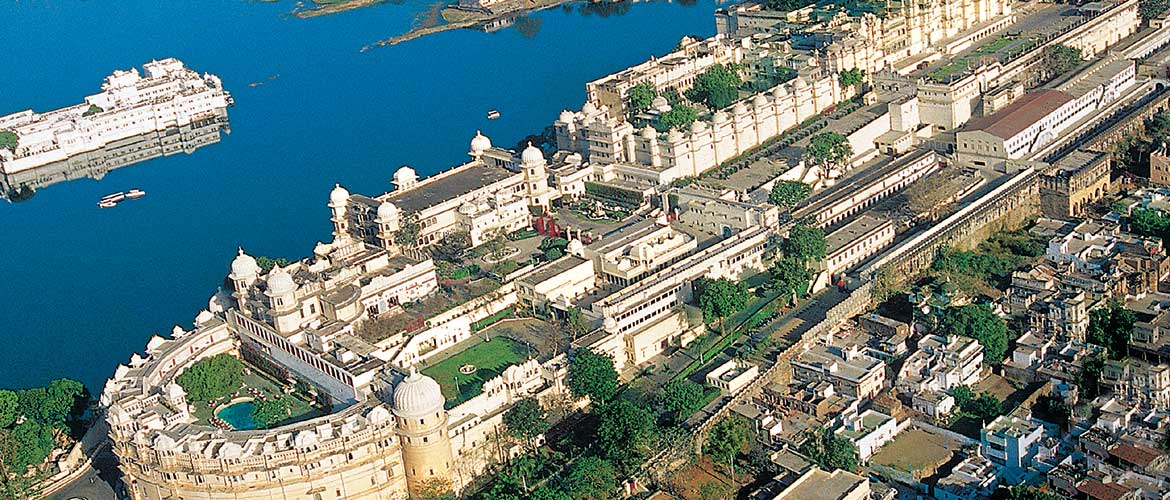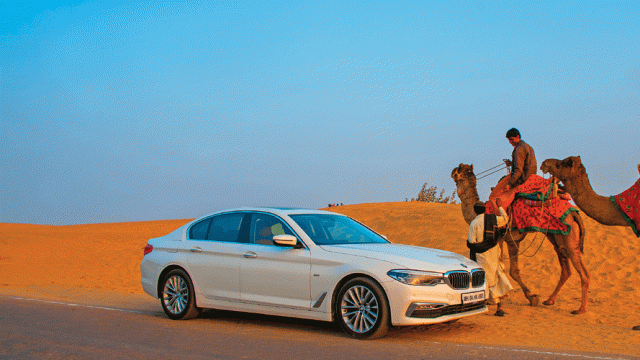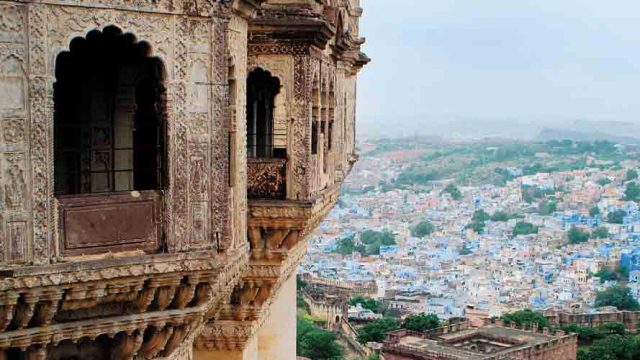A tourist’s itinerary in Udaipur inevitably revolves around the sites of the erstwhile rulers: the
All these places today dutifully echo a fictional history in which the Sisodia Rajput rulers of Mewar are famous for their virtues, victories and fierce independence. However, the splendours of Udaipur’s architectural heritage belong mainly to the peaceful periods when Mewar accepted at first the sovereignty of the Mughals and later that of the British.
The Old City is to the east of Lake Pichola. The city wall is hardly seen, but many areas are still known by the gate names of yore: Suraj Pol, Hathi Pol, et al. The City Palace sits on the east bank of Lake Pichola, with its back towards it.

The tourist hub is to the north of City Palace. Fateh Sagar Lake is further north. The train station and the bus stand are just outside the Old City. The airport is 25km from the city centre to the east. An auto for the day should cost ₹600–800. If you are planning a short trip to, say, Jaisamand, the taxi fare for the day should be ₹1,500–2,200. There are numerous travel agents around the city centre, and it’s best to compare rates or ask your hotel to arrange a taxi.
Things to See & Do
City Palace complex
This is where it all began in the 16th century when Udai Singh met a sage who advised him to establish a city here. Now the complex is a conglomeration of palaces built over 400 years. This largest palace complex in Rajasthan is a fascinating edifice. 22 maharajas of Udaipur contributed to this structure and yet it maintains a graceful uniformity. Despite its huge size and the profusion of architectural elements – jharokhas, columns and towers – the elegant palace has an airy lightness about it. Perhaps that’s because of its creamy hue. It also gels easily with the blue waters of Lake Pichola.
Keep aside a few hours to explore the City Palace. Walk up the hill from Jagdish Temple, buy your tickets at Badi Pol, and enter the complex. After Badi Pol, the imposing Tripolia Gate welcomes you, with seven arches or toranas to its left, commemorating the seven times when the maharajas were weighed against silver and gold, which was then distributed among the people. On the right is a wall called Agad, across which elephants were made to fight each other – a royal idea of sport.

Further ahead is the entrance to the palace building and above the entrance, the Mewar crest, an image of the Sun God (from whom the Mewar royalty claim to have descended), flanked by a Rajput warrior and a Bhil. A part of the City Palace Museum in the complex has been made the Government Museum. Shambhu Niwas is the present home of the royal family. Further south are Fateh Prakash Palace and Shiv Niwas Palace, both of which are luxury hotels today.
City Palace Museum
Ganesh Deori leads you into the City Palace Museum, and you enter a maze of narrow passages, steep staircases, terraces, patios and apartments. Just inside the entrance, where your tickets will be checked, notice the paintings of the important Krishna deities of Mewar – Srinathji, Eklingji and Charbhujaji – all lovely examples of the Mewar School of painting. Now begins a series of mahals and chowks, with their names, dates of construction and the names of builders displayed prominently, but soon you will be lost – in a world of luxury, indulgence and comfort. Note the Rajya Aangan, the spot where Udai Singh met the sage. Chandra Mahal, with elegant columns and beautiful windows, is a great palace with stunning views of Lake Pichola, its islands and the surrounding hills. Badi Mahal, or Amar Vilas, was built on a rock formation and ingeniously incorporated into the complex with an enclosed garden. The Kaanch Ki Burj is a chamber with its walls inlaid with red and silver glass. The Krishna Niwas has some remarkable miniature Mewar paintings. A room is dedicated to James Tod, displaying a manuscript of his Annals alomg with his portrait. The Mor Chowk, originally built in 1620, was decked with brilliantly coloured mosaics of three dancing peacocks in the 19th century. The Zenana Mahal has princesses’ apartments.
Entry Adults ₹250; Children ₹100 Timings 9.30am–4.30pm Open all days Photography ₹250 Sound & Light fee Adults ₹250–500; Children ₹100–200 Timings 7.00–8.00pm (English) eternalmewar.in

Crystal Gallery
The Crystal Gallery has a profligate display of wealth. In a shopping binge, Rana Sajjan Singh ordered an assortment of crystal objects from F&C Osler & Co in England in 1877. He died before the crystal chairs, beds, sofas, glasses, and dinner sets arrived in Udaipur. Successors thought this was a bad omen and the extraordinary bequest stayed packed in boxes for 110 years before somebody thought of making money from this misadventure. The rather over-priced admission fee includes the entry charges to the grand Durbar Hall of the Fateh Prakash Palace and a drink in the Gallery Restaurant.
Location Fateh Prakash Palace Entry Adults ₹550; Children ₹350 (includes entry fee to palace premises and a beverage) Timings 10.00am–6.00pm, open all days
Tip Cameras are not allowed here
Vintage cars
About 2km away from the City Palace complex is the Vintage and Classic Car Collection, where about two dozen vehicles are on display in garages. There’s a 1934 Rolls Royce Phantom II and a 1939 Cadillac convertible, which transported Jackie Kennedy during her visit.
Entry Adults ₹250; Children ₹150 Lunch/dinner coupon Adult ₹200; Children ₹150 Timings 9.30am–8.00pm
Open daily
Lake Pichola
Although its name means ‘the backyard’, Lake Pichola is the centre of imagination in Udaipur. The town grew up on the shores of Pichola and now lives on its banks. Palaces and hills hug its contours. Havelis and houses and hotels find sustenance in its waters. When the lake is full, people bathe in it, swim and take boat rides, or simply gaze at it. When Pichola is dry, camels and buffaloes graze on its surface, and every heart sinks.

You can sit in the numerous rooftop restaurants on Lal Ghat, Gangaur Ghat and Hanuman Ghat and enjoy the lake and its environs. You can take a sunset boat ride from the City Palace jetty on Bansi Ghat (Fee: Adult ₹700; Children ₹400 for 1hr) and enjoy wonderful views of the lake’s shores and its elegant buildings. The lake has two island palaces, Jagmandir and Jagniwas. The palace on Jagmandir Island was built in the 17th century and its courtyard has a restaurant. The Jagniwas Island hosts the Taj Lake Palace hotel. The longer boat ride includes a 20-minute halt at Jagmandir Island.
Jagdish Temple
Built in 1651 in the Indo-Aryan style, the temple is located high above the streets, on a crossroad. The outer walls have carvings typical of Mewar temples, and Vishnu, as Jagannath, is chief deity.
Sanctum Timings 5.00am–2.00pm & 4.00–11.00pm
Udaipur’s Seven Sisters
Udaipur’s rulers understood the importance of water, built dams and created reservoirs. You can see some of the most amazing and artistic engineering feats in Udaipur’s lakes: Pichola, Dudh Talai, Govardhan Sagar, Kumaria Talav, Rangsagar, Swaroop Sagar and Fateh Sagar. Collectively, they are called the seven sisters of Udaipur, and there are more. These water bodies have been Udaipur’s lifeline over centuries. All these lakes are inter-connected, and the surplus water from one flows into the next.
Shopping
The touristy areas near City Palace, Jagdish Temple, Lalghat and Gangaur Ghat are akin to a huge shopping plaza selling artefacts and crafts. Miniature paintings are Udaipur’s most famous craft. There are many painters and scores of shops selling miniatures done on paper, cloth, stone and wood (₹50–80 upwards). Silver jewellery, handmade paper, fabrics, papier-mâché, wooden and stone statues, and block-printed clothes are on offer. Much time can be spent in the shops outside the City Palace, and the government-run Rajasthali showroom near the Jagdish Temple. Inside the City Palace complex, in the big courtyard beyond Tripolia Gate, are three shops: Anokhi, selling block-printed cottons, Aashka, with souvenirs and Anmol offering gems and jewellery. Mystique, at 14, Lalghat, is a more upmarket shop for textiles and curios. The wares sold at Shilpgram, a crafts village built about 3km west of Fateh Sagar Lake, are not necessarily of better quality, but all the money goes into the artisan’s pocket. If you are looking for pichhwais, pigment-painted temple hangings, Raja Ram Sharma’s Studio near Brahm Pol (Tel: 0294-2432763) is a good place to visit. He executes new compositions using traditional pigments and has a few paintings in stock, but the bulk of his work is executed to order.
Where to Stay
Udaipur has a wide range of stay options but make an advance booking during the tourist season. As is to be expec-ted, the most romantic, scenic and exhilarating stay options are around Lake Pichola. Some of these are also the most expensive. However, there are scores of budget and mid-range hotels around Lake Pichola and near Fateh Sagar Lake.
The 18th-century traditional summer palace of the erstwhile rulers, Taj Lake Palace (Tel: 0294-2428800; Tariff: ₹60,000–8,50,000), on the Jagniwas Island in Lake Pichola, is a dream stay option. You can expect all imaginable luxuries and more here.
The restored Amet Haveli (Tel: 2431085; Tariff: ₹6,800–7,900) has an enchanting location on Hanuman Ghat. Oberoi Udaivilas (Tel: 2433300; Tariff: ₹60,000–7,50,000) promises you the experience of staying in your own palace with your own piece of Lake Pichola.
Pahvna Haveli (Tel: 2428617, 6536467; Tariff: ₹2,500–3,000), a homestay in Sardarpura, and Kankarwa Haveli (Tel: 2521403; Tariff: ₹2,200– 6,000) on Lal Ghat are value for money. Among the budget hotels, try RTDC’s Hotel Kajri (Tel: 2410501-03; Tariff: ₹1,000–2,900), perched on a hilltop 3km from the lakefront. It has its own restaurant and parking and is within easy reach of the railway station.
Where to Eat
Udaipur is bursting with romantic and dreamy eating joints – rooftop cafes, lakeview eateries, and restaurants on the lake – but it is sadly deficient in good food. Most places serve passable Indian and Continental food, so it’s best to just enjoy the ambience.
Ambrai, the open-air restaurant in Amet Haveli, offers a few Rajasthani specialities, including mutton soweta, a dish that uses corn.
For basic vegetarian Rajasthani fare, head to Santosh Daal Baati Bhojanalaya, where you can have dal-bati-choorma. The rooftop terrace at Udai Kothi serves good dal makhani and tandoori chicken and fish.
Café Edelweis on Gangaur Ghat is popular for its coffee and Continental snacks. For a cheap thali, you should go to Garden Hotel Restaurant on Lake Palace Road.
Fast Facts
When to go October–February is the best time to visit, however July–August is pleasant during rains
Tourist Office
Rajasthan Tourism Office, Fateh Memorial, Suraj Pol, Udaipur, Tel: 0294-2411535
STD Code 0294
Getting There
Air Udaipur’s Maharana Pratap (Dabok) Airport, (25km/ 45mins) is connected to Jaipur, Jodhpur, Delhi and Mumbai. Taxi ₹750–1,050 to the centre of town
Rail Udaipur Station is well connected with Delhi by the Mewar Express that runs from Nizamuddin Station. Taxis and autos are readily available outside
Road NH8 connects Udaipur to Jaipur, Delhi, Ahmedabad and Mumbai Bus Volvo services available between Jaipur and Udaipur (489km; ₹900), from Jaipur’s Sindhi Camp Central Bus Stand (Tel 0141-2204445) rsrtconline. rajasthan.gov.in
Udaipur
travel
India





